

# systemctl status should see output indicating that the tunnel service is running and for how long - Setup a secure tunnel to example_tunnel1 Loaded: loaded enabled vendor preset: disabled) Active: active ( running) since Mon 12:33:32 EET 1h 32min ago
UNIX SSH TUNNEL HOW TO
Provide the tunnel configuration file as parameter after the systemctl start command # systemctl start How to check if a tunnel runs This will force systemctl to reload systemd manager configuration What to do after creating a new tunnel configuration file.TARGET ← The SSH gateway between the local machine and the remote serverĪs you can see there an one to one matching of the template and the configuration file options How to manage the systemd tunnel services - common operations.


REMOTE_PORT ← The remote host port end of the tunnel.REMOTE_HOST ← The remote host end of the tunnel.LOCAL_PORT ← The local port of the local ip.LOCAL_ADDR ← The local ip to bind the tunnel.This configuration requires ssh keys in order to communicate with the SSH GatewayĬreate the following template Description=Setup a secure tunnel to %I After=network.target Environment="LOCAL_ADDR=localhost" ExecStart=/usr/bin/ssh -NT -o ServerAliveInterval=60 -o ExitOnForwardFailure=yes -L $ ← The SSH gateway between the local machine and the remote serverĬreate the following file will hold the actual tunnel configuration options, here is an example fileĬontent: TARGET=gateway1 TUSER=root LOCAL_ADDR=127.0.0.1 LOCAL_PORT=49998 REMOTE_PORT=443 REMOTE_HOST=10.1.1.1 Much often you will need a constant SSH tunnel connection, to avoid the administrative load for those tunnels after a reboot is to configure them as systemd services and use SSH keys to avoid passwords.Īlso its nice and super helpfull to create the systemd service as a template that can accept tunnel parameters from a file, this allow very easily to manage your tunnels (add,delete,modify,start,stop).
UNIX SSH TUNNEL WINDOWS
The most popular Windows SSH client is PuTTY.Linux: How to create an SSH tunnel as a systemd service
UNIX SSH TUNNEL INSTALL
Windows users will first need to download and install an SSH client program. To terminate the SSH tunnel type CTRL+C in the console where the ssh client is running. When prompted, enter the MySQL user password. Where MYSQL_USER is the remote MySQL user having privileges to access the database. Now you can point your local machine MySQL client to 127.0.0.1:3336 enter the remote database login credentials and access the MySQL server.įor example, to connect to the MySQL server using the command line mysql client you would issue: mysql -u MYSQL_USER -p -h 127.0.0.1 It is a good idea to set up an SSH key-based authenticationĪnd connect to the server without entering a password. After entering it, you will be logged in to the server, and the SSH tunnel will be established. Once you run the command, you’ll be prompted to enter your SSH user password. (the default) specify the port with the -p option.


 0 kommentar(er)
0 kommentar(er)
